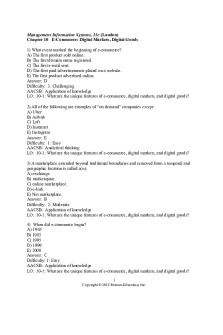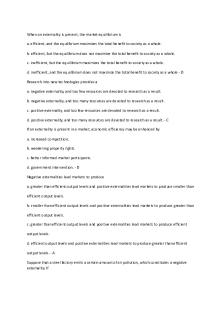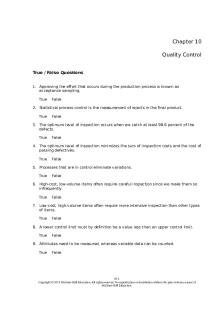TBChap 010-1 - Chap 10 test questions PDF

| Title | TBChap 010-1 - Chap 10 test questions |
|---|---|
| Author | Mohsen Karim |
| Course | Games of Strategy and Incentives |
| Institution | University of Maryland |
| Pages | 16 |
| File Size | 210.5 KB |
| File Type | |
| Total Downloads | 80 |
| Total Views | 202 |
Summary
Chap 10 test questions ...
Description
Chapter 10 Quality Control
True / False Questions 1. Approving the effort that occurs during the production process is known as acceptance sampling. True
False
2. Statistical process control is the measurement of rejects in the final product. True
False
3. The optimum level of inspection occurs when we catch at least 98.6 percent of the defects. True
False
4. The optimum level of inspection minimizes the sum of inspection costs and the cost of passing defectives. True
False
5. Processes that are in control eliminate variations. True
False
6. High-cost, low-volume items often require careful inspection since we make them so infrequently. True
False
7. Low-cost, high-volume items often require more intensive inspection than other types of items. True
False
8. A lower control limit must by definition be a value less than an upper control limit. True
False
9. Attributes need to be measured, whereas variable data can be counted. True
False
10-1 Copyright © 2015 McGraw-Hill Education. All rights reserved. No reproduction or distribution without the prior written consent of McGraw-Hill Education.
10. The amount of inspection we choose can range from no inspection at all to inspecting each item numerous times. True
False
11. The amount of inspection needed is governed by the costs of inspection and the expected costs of passing defective items. True
False
12. The purpose of statistical process control is to ensure that historical output is random. True
False
13. A process that exhibits random variability would be judged to be out of control. True
False
14. If a point on a control chart falls outside one of the control limits, this suggests that the process output is nonrandom and should be investigated. True
False
15. An x-bar control chart can only be valid if the underlying population it measures is a normal distribution. True
False
16. Concluding that a process is out of control when it is not is known as a Type I error. True
False
17. An R value of zero (on a range chart) means that the process must be in control since all sample values are equal. True
False
18. Range charts are used mainly with attribute data. True
False
19. Range charts and p-charts are both used for variable data. True
False
20. A p-chart is used to monitor the fraction of defectives in the output of a process. True
False
21. A c-chart is used to monitor the total number of defectives in the output of a process. True
False
10-2 Copyright © 2015 McGraw-Hill Education. All rights reserved. No reproduction or distribution without the prior written consent of McGraw-Hill Education.
22. A c-chart is used to monitor the number of defects per unit for process output. True
False
23. Tolerances represent the control limits we use on the charts. True
False
24. Process capability compares process variability to the tolerances. True
False
25. Control limits used on process control charts are specifications established by design or customers. True
False
26. Control limits tend to be wider for more variable processes. True
False
27. Patterns of data on a control chart suggest that the process may have nonrandom variation. True
False
28. The output of a process may not conform to specifications even though the process may be statistically "in control." True
False
29. Run tests are useful in helping to identify nonrandom variations in a process. True
False
30. Run tests give managers an alternative to control charts; they are quicker and cost less. True
False
31. Statistical process control focuses on the acceptability of process output. True
False
32. A run test checks a sequence of observations for randomness. True
False
33. Cpk is useful even when the process is not centered. True
False
10-3 Copyright © 2015 McGraw-Hill Education. All rights reserved. No reproduction or distribution without the prior written consent of McGraw-Hill Education.
34. The process capability index (indicated by Cpk) can be used only when the process is centered. True
False
35. Quality control is making sure that processes are performing in an acceptable manner. True
False
36. The primary purpose of statistical process control is to detect a defective product before it is shipped to a customer. True
False
37. The Taguchi loss function suggests that the capability ratio can be improved by extending the spread between LCL and UCL. True
False
38. The variation of a sampling distribution is tighter than the variation of the underlying process distribution. True
False
39. The sampling distribution can be assumed to be approximately normal even when the underlying process distribution is not normally distributed. True
False
40. Approximately 99.7 percent of sample means will fall within plus or minus two standard deviations of the process mean if the process is under control. True
False
41. The best way to assure quality is to use extensive inspection and control charts. True
False
42. Control limits are based on multiples of the process standard deviation. True
False
43. Attribute data are counted, variable data are measured. True
False
44. The number of defective parts in a sample is an example of variable data because it will "vary" from one sample to another. True
False
45. Larger samples will require wider x-bar control limits because there is more data. True
False
10-4 Copyright © 2015 McGraw-Hill Education. All rights reserved. No reproduction or distribution without the prior written consent of McGraw-Hill Education.
46. When a process is not centered, its capability is measured in a slightly different way. The symbol for this case is Cpk. True
False
47. Range control charts are used to monitor process central tendency. True
False
Multiple Choice Questions 48. Quality control, in contrast to quality assurance, is implemented:
A. during production. B. by top management. C. after production. D. by self-directed teams. E. before inspection. 49. The more effective and all-encompassing a firm's quality control and continuous improvement efforts, the less that company will need to rely on:
A. insourcin g. B. inspectio n. C. outsourcin g. D. acceptance sampling. E. capability assessment.
10-5 Copyright © 2015 McGraw-Hill Education. All rights reserved. No reproduction or distribution without the prior written consent of McGraw-Hill Education.
50. Quality control tools are not really used to fix quality so much as they are used to:
A. highlight when processes are not capable. B. point out when random variation is present. C. alert when corrective action is needed. D. monitor the quality of incoming shipments or outgoing finished goods. E. initiate team-building exercises. 51. The assurance that processes are performing in an acceptable manner is the focus of:
A. variability analysis. B. quality assurance. C. capability assessment. D. quality control. E. acceptance sampling. 52. Inspection is a(n):
A. preventio n. B. contro l. C. monitorin g. D. correctiv e. E. appraisa l.
10-6 Copyright © 2015 McGraw-Hill Education. All rights reserved. No reproduction or distribution without the prior written consent of McGraw-Hill Education.
53. Acceptance sampling, when it is used, is used: (I) before production. (II) during production. (III) after production.
A. I only B. I and III only C. I and II only D. II and III only E. I, II, and III 54. The amount of inspection needed depends on __________ and __________.
A. the amount of automation; the reliability of inspectors B. the quality of the supplier; the target market of the process C. the costs of inspection; the costs of passing on defective items D. where in the process the inspection occurs; the volume of the process E. the cost of the item being inspected; the use of the item being inspected 55. The greater the volume of the process being targeted for inspection, the more attractive __________ inspection is.
A. monitor ed B. controll ed C. periodi c D. variabl e E. automat ed
10-7 Copyright © 2015 McGraw-Hill Education. All rights reserved. No reproduction or distribution without the prior written consent of McGraw-Hill Education.
56. Which of the following quality control sample statistics indicates a quality characteristic that is an attribute?
A. mea n B. varianc e C. standard deviation D. rang e E. proporti on 57. A time-ordered plot of representative sample statistics is called a(n):
A. Gantt chart. B. simo chart. C. control chart. D. up-down matrix. E. standard deviation table. 58. A control chart used to monitor the process mean is the:
A. pchart. B. Rchart. C. x-bar chart. D. cchart. E. Gantt chart.
10-8 Copyright © 2015 McGraw-Hill Education. All rights reserved. No reproduction or distribution without the prior written consent of McGraw-Hill Education.
59. A control chart used to monitor the fraction of defectives generated by a process is the:
A. pchart. B. Rchart. C. x-bar chart. D. cchart. E. Gantt chart. 60. A p-chart would be used to monitor:
A. average shrinkage. B. dispersion in sample data. C. the fraction defective. D. the number of defects per unit. E. the range of values. 61. A c-chart is used for:
A. mean s. B. range s. C. percent defective. D. fraction defective per unit. E. number of defects per unit.
10-9 Copyright © 2015 McGraw-Hill Education. All rights reserved. No reproduction or distribution without the prior written consent of McGraw-Hill Education.
62. A control chart used to monitor the number of defects per unit is the:
A. pchart. B. Rchart. C. x-bar chart. D. cchart. E. Gantt chart. 63. A point which is outside of the lower control limit on an R-chart:
A. is an indication that no cause of variation is present. B. should be ignored because it signifies better-thanaverage quality. C. should be investigated because an assignable cause of variation might be present. D. should be ignored unless another point is outside that limit. E. is impossible since the lower limit is always zero. 64. If a process is performing as it should, it is still possible to obtain observations which are outside of which limits? (I) tolerances (II) control limits (III) process variability
A. I B. I I C. I and II D. II and III E. I, II, and III
10-10 Copyright © 2015 McGraw-Hill Education. All rights reserved. No reproduction or distribution without the prior written consent of McGraw-Hill Education.
65. Which of the following relationships must always be incorrect?
A. Tolerances > process variability > control limits B. Process variability > tolerances > control limits C. Tolerances > control limits > process variability D. Process variability > control limits > tolerances E. Process variability < tolerances < control limits 66. Which of the following is not a step in the quality control process?
A. Define what is to be controlled. B. Compare measurements to a standard. C. Eliminate each of the defects as they are identified. D. Take corrective action if necessary. E. Evaluate corrective action. 67. The probability of concluding that assignable variation exists when only random variation is present is: (I) the probability of a Type I error. (II) known as the alpha risk. (III) highly unlikely. (IV) the sum of probabilities in the two tails of the normal distribution.
A. I and II B. I and IV C. II and III D. I, II, and IV E. I, III, and IV
10-11 Copyright © 2015 McGraw-Hill Education. All rights reserved. No reproduction or distribution without the prior written consent of McGraw-Hill Education.
68. _______ variation is a variation whose cause can be identified.
A. Assignabl e B. Controllab le C. Rando m D. Statistic al E. Theoretic al 69. A plot below the lower control limit on the range chart: (I) should be ignored since lower variation is desirable. (II) may be an indication that process variation has decreased. (III) should be investigated for assignable cause.
A. I and II B. I and III C. II and III D. II only E. I, II, and III 70. A shift in the process mean for a measured characteristic would most likely be detected by a:
A. pchart. B. x-bar chart. C. cchart. D. Rchart. E. schart.
10-12 Copyright © 2015 McGraw-Hill Education. All rights reserved. No reproduction or distribution without the prior written consent of McGraw-Hill Education.
71. The range chart (R-chart) is most likely to detect a change in:
A. proportio n. B. mea n. C. number defective. D. variabilit y. E. sample size. 72. The optimum level of inspection is where the:
A. cost of inspection is minimum. B. cost of passing defectives is minimum. C. total cost of inspection and defectives is maximum. D. total cost of inspection and defectives is minimum. E. difference between inspection and defectives costs is minimum. 73. The purpose of control charts is to:
A. estimate the proportion of output that is acceptable. B. weed out defective items. C. determine if the output is within tolerances/specifications. D. distinguish between random variation and assignable variation in the process. E. provide meaningful work for quality inspectors.
10-13 Copyright © 2015 McGraw-Hill Education. All rights reserved. No reproduction or distribution without the prior written consent of McGraw-Hill Education.
74. The process capability index (Cpk) may mislead if: (I) the process is not stable. (II) the process output is not normally distributed. (III) the process is not centered.
A. I and II B. I and III C. II and III D. II only E. I, II, and III 75. A time-ordered plot of sample statistics is called a(n) ______ chart.
A. statistic al B. inspecti on C. contr ol D. sim o E. lim it 76. Consider the following information:
The number of runs up and down for the preceding data is:
A. 3 . B. 4 . C. 5 . D. 6 . E. none of these.
10-14 Copyright © 2015 McGraw-Hill Education. All rights reserved. No reproduction or distribution without the prior written consent of McGraw-Hill Education.
77. Consider the following information:
The number of runs with respect to the sample median is:
A. 3 . B. 4 . C. 5 . D. 6 . E. none of these. 78. The following data occurs chronologically from left to right:
The number of runs with respect to the sample median is:
A. 2 . B. 3 . C. 4 . D. 5 . E. none of these.
10-15 Copyright © 2015 McGraw-Hill Education. All rights reserved. No reproduction or distribution without the prior written consent of McGraw-Hill Education.
79. The following data occurs chronologically from left to right:
The number of runs up and down is:
A. 2 . B. 3 . C. 4 . D. 5 . E. none of these. 80. A design engineer wants to construct a sample mean chart for controlling the service life of a halogen headlamp his company produces. He knows from numerous previous samples that this service life is normally distributed with a mean of 500 hours and a standard deviation of 20 hours. On three recent production batches, he tested service life on random samples of four headlamps, with these results:
What is the sample mean service life for sample 2?
A. 460 hours B. 495 hours C. 500 hours D. 515 hours E. 525 hours
10-16 Copyright © 2015 McGraw-Hill Education. All rights reserved. No reproduction or distribution without the prior written consent of McGraw-Hill Education....
Similar Free PDFs

TBChap 001 - Test stuff
- 70 Pages

TBChap 015 - TEST BANK
- 33 Pages

TBChap 008 - TEST BANK
- 43 Pages

TBChap 004 - Test Bank
- 68 Pages

TBChap 002 - test bank
- 8 Pages

TBChap 003 - test bank
- 12 Pages

TBChap 012 - TEST BANK
- 26 Pages

TBChap 011 - questions and answer
- 26 Pages

Bates Test questions Chapter 10
- 10 Pages

Chapter 0101
- 2 Pages

Chap 10. economics
- 15 Pages

chap 10 testbank
- 24 Pages

Econ 2100 chap 10
- 3 Pages

Chap 15 test bank
- 20 Pages
Popular Institutions
- Tinajero National High School - Annex
- Politeknik Caltex Riau
- Yokohama City University
- SGT University
- University of Al-Qadisiyah
- Divine Word College of Vigan
- Techniek College Rotterdam
- Universidade de Santiago
- Universiti Teknologi MARA Cawangan Johor Kampus Pasir Gudang
- Poltekkes Kemenkes Yogyakarta
- Baguio City National High School
- Colegio san marcos
- preparatoria uno
- Centro de Bachillerato Tecnológico Industrial y de Servicios No. 107
- Dalian Maritime University
- Quang Trung Secondary School
- Colegio Tecnológico en Informática
- Corporación Regional de Educación Superior
- Grupo CEDVA
- Dar Al Uloom University
- Centro de Estudios Preuniversitarios de la Universidad Nacional de Ingeniería
- 上智大学
- Aakash International School, Nuna Majara
- San Felipe Neri Catholic School
- Kang Chiao International School - New Taipei City
- Misamis Occidental National High School
- Institución Educativa Escuela Normal Juan Ladrilleros
- Kolehiyo ng Pantukan
- Batanes State College
- Instituto Continental
- Sekolah Menengah Kejuruan Kesehatan Kaltara (Tarakan)
- Colegio de La Inmaculada Concepcion - Cebu

